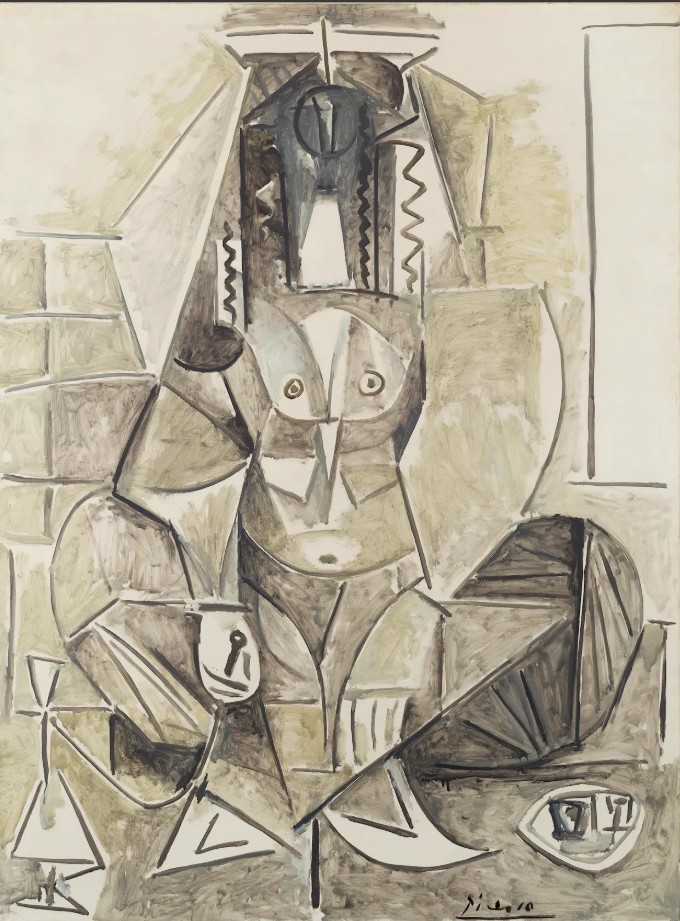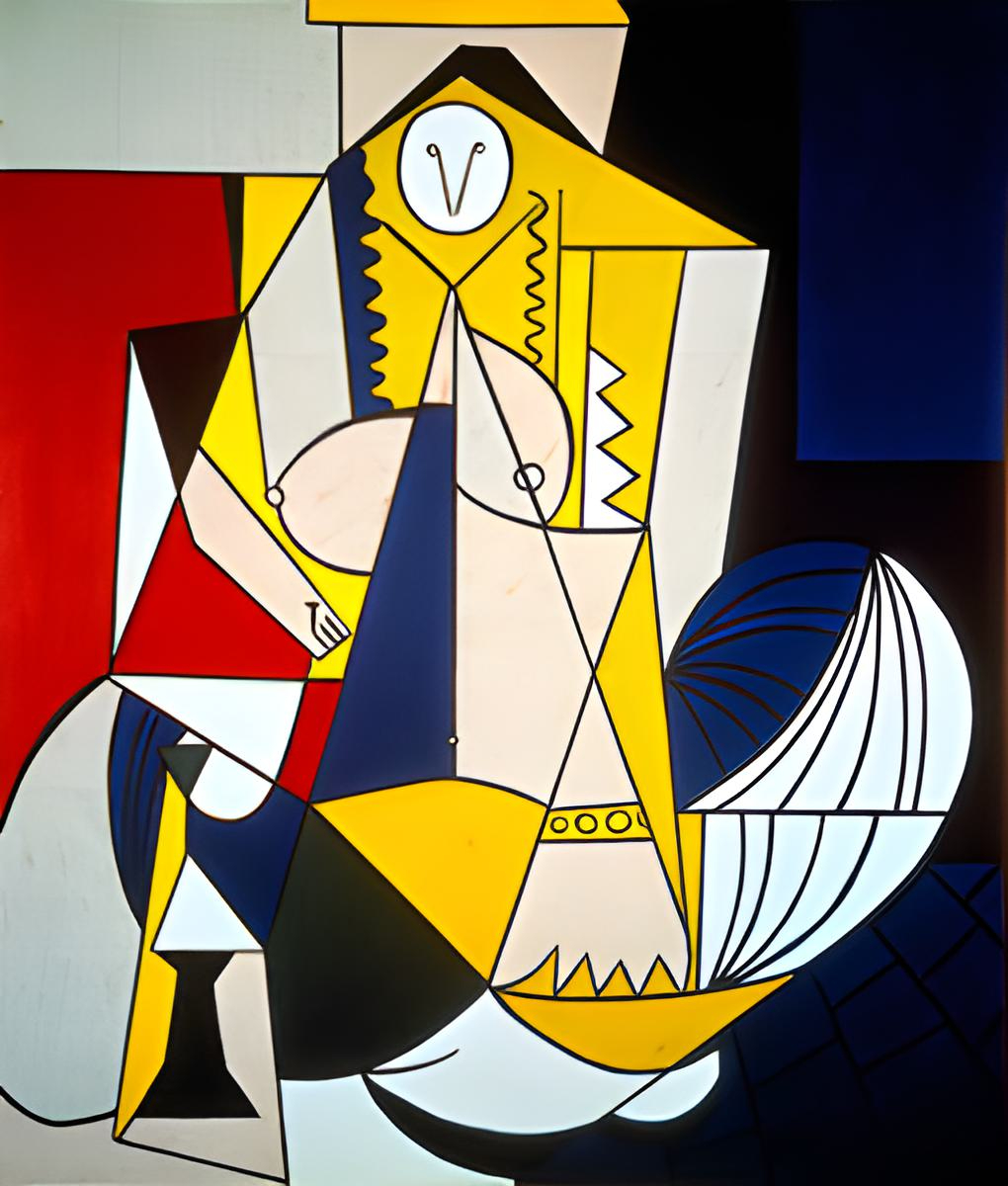1963 Femme d’Algier, by Roy Lichtenstein is a reworking and reformulation of Picasso’s artwork featured below, “Les Femmes d’Alger”

Though Roy Lichtenstein is best known for his comic-strip-inspired paintings and hard-edged Pop Art sensibility, his work is deeply entwined with the legacy of Pablo Picasso. Far from merely parodying mass media, Lichtenstein was in active dialogue with the history of modern art, and few figures loomed larger in that conversation than Picasso. In fact, Lichtenstein’s career can be read, in part, as a sustained interrogation — both critical and admiring — of the language, methods, and mystique of Picasso as the quintessential modernist.
1. Picasso as the Artist to React Against — and with
For Lichtenstein, Picasso was both the model to emulate and the monument to question. The early 1960s saw Lichtenstein rise to fame as a leading figure of the Pop Art movement, a radical shift away from Abstract Expressionism and its intense subjectivity. Picasso, while not an Abstract Expressionist, had similarly mythologized the artist’s ego, spontaneity, and gestural power.
Lichtenstein’s response was one of ironic reverence. He appropriated Picasso’s stylistic devices — particularly Cubism — and recontextualized them using the visual language of mass production, thereby commenting on the commodification of both art and artistic genius. In doing so, Lichtenstein neither dismissed Picasso nor blindly revered him; he dissected him.
2. Lichtenstein’s “Cubist Picassos” — Art about Art
Lichtenstein’s explicit “Picasso” paintings, created mainly in the 1970s and early 1980s, are central to understanding this influence. Works like “Still Life with Picasso” (1973) or “Cubist Still Life with Playing Cards” (1974) are direct parodies and homages. They reimagine Picasso’s Cubist still lifes and portraits through Lichtenstein’s signature Ben-Day dots, bold outlines, and commercial flatness.
These paintings are not copies, but translations — filtered through the sensibility of advertising and mass media. Lichtenstein flattens Picasso’s fractured planes, sterilizes his spontaneous brushwork, and remakes the master’s iconic forms with industrial precision. In essence, he was asking: What happens to Picasso’s revolutionary style when it’s filtered through the culture of mass reproduction?
This is where Lichtenstein’s genius lies — not in lampooning Picasso, but in reimagining him for the Pop Art era, where a Picasso could be both museum treasure and coffee mug motif.
3. Picasso’s Women, Reimagined
Another recurring target of Lichtenstein’s Picasso quotations is the female form — a subject that obsessed both artists. Picasso’s portraits of women, particularly Dora Maar and Marie-Thérèse Walter, are among his most recognizable. Lichtenstein appropriated these iconic compositions, then stylized them through his Pop lens — emphasizing the artificiality and cultural coding of beauty.
For example, in Lichtenstein’s “Woman with Flowered Hat” (1963), he reworks Picasso’s portrait of Dora Maar, originally a writhing, emotionally charged expressionist composition, into a flat, graphic, comic-like parody. But this parody is not superficial. It critiques not only Picasso’s representation of women, but also the way modernist art itself became a commodity, sold, reproduced, and consumed like comic books.
4. Formal Influence: Fragmentation and Stylization
On a formal level, Picasso’s Cubist deconstruction of space and form laid the groundwork for Lichtenstein’s own experiments in flattened perspective, overlapping planes, and visual stylization. While Lichtenstein abandoned the gestural freedom of Cubism, he retained its core strategy: breaking down reality into abstracted, symbolic forms.
His famous comic panels are Cubist in spirit — slicing narratives into disconnected fragments, removing context, and reducing figures to archetypes. Picasso gave Lichtenstein permission to treat visual language as a mutable system, something to be manipulated and subverted.
5. Persona, Style, and the Myth of the Artist
Finally, Picasso’s larger-than-life persona as the genius artist was something Lichtenstein, like Warhol, grappled with. While Picasso cultivated an image of raw creative power, Lichtenstein projected deliberate detachment. His mechanical style and comic-book motifs were a direct challenge to the romantic myth of the tortured artist.
Yet, paradoxically, Lichtenstein became a kind of ironic genius himself — an artist whose quotations of Picasso were both critical and celebratory, forming a mirror through which to question authorship, originality, and artistic legacy.
Conclusion: Picasso Refracted Through Pop
Roy Lichtenstein did not merely reference Picasso — he deconstructed him, reinterpreted him, and placed him in the bright, ironic glare of postwar American consumer culture. Where Picasso broke down visual form to expose its inner structure, Lichtenstein broke it down again to show how easily it could be packaged and sold.
Yet the influence is unmistakable. Picasso gave Lichtenstein a visual and philosophical vocabulary that he could adopt and subvert — from fragmentation of form, to the mythic image of the artist, to the visual treatment of the female figure. In this way, Lichtenstein’s art is not an end to modernism, but a Pop-infused continuation — a dialogue with Picasso that is simultaneously critique, homage, and transformation.

